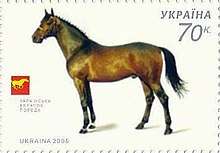Ukrainian Riding Horse
The Ukrainian Riding Horse (Ukrainian: украї́нський верхови́й кінь) or Ukrainian Saddle Horse is a modern Ukrainian breed of warmblood sport horse. Breeding began in the years after the Second World War at the stud farm of Dnipropetrovsk in central Ukraine – at that time in the USSR – and later expanded to three other state stud farms. It derives from cross-breeding of Hanoverian, Thoroughbred and Trakehner stallions with local mares or with Hungarian Furioso, Gidran Arab or Nonius mares. It incorporates the last bloodlines of the extinct Orlov-Rostopchin or Russian Saddle Horse.[5]:115 It was bred to compete in show jumping, three-day eventing and dressage, but is also suitable as a general riding horse.[6]:250
 On a Ukrainian postage stamp, 2005 | |
| Conservation status | |
|---|---|
| Other names | |
| Country of origin | Ukraine |
| Distribution | throughout the country[2] |
| Use |
|
| Traits | |
| Height | |
| Colour | dark colours[4]:510 |
History
Breeding of the Ukrainian Saddle Horse began in the years after the Second World War at the stud farm of Dnipropetrovsk, in Dnipropetrovsk Oblast in central Ukraine, which at that time was part of the Soviet Union.[3]:309 Breeding was based principally on cross-breeding of Hanoverian, Thoroughbred and Trakehner stallions with mares of local or of Hungarian Furioso, Gidran Arab or Nonius stock, but also incorporated the last bloodlines of the extinct Orlov-Rostopchin or Russian Saddle Horse.[5]:115
Breeding expanded to three other state stud farms: the Oleksandriysky stud at Likarivka in Oleksandriia Raion of Kirovohrad Oblast in central Ukraine: the Provalsky stud at Provallya in Sverdlovsk Raion of Luhansk Oblast in the easternmost part of Ukraine; and the Skadovsky stud at Bilozerka in Kherson Oblast in the south of the country. When these were closed, breeding continued at Dnipropetrovsk, and some horses were moved to the historic Derkulsky Stud at Danilivka, in Bilovodsk Raion of Luhansk Oblast, and to the Yagilnytsky Stud at Yahilnytsia in Chortkiv Raion of Ternopil Oblast in the western part of the country. From 1975 breeding was also carried out at the Lozivsky stud farm at Kinne, in Lozivsky Raion of Kharkiv Oblast in eastern Ukraine.[7]
There are seven lines within the breed, of which the Bespechny is closest to the extinct Orlov-Rostopchin breed.[7][6]:250
A stud-book was begun in 1971.[2] The breed received the official approval of the State Committee for Food and Procurement of the Council of Ministers of the USSR in 1990,[7] not long before the break-up of the Soviet Union and the independence of Ukraine.
In 2004 there were 1393 horses registered, distributed among 5 state stud farms and 20 breeders in 13 of the oblasts of Ukraine; of these, 84 were stallions. This represented about 23% of the total purebred horse population of the country, and was slightly lower than the numbers of the Russian Trotter, the most numerous breed.[8]:31
Characteristics
The Ukrainian Riding Horse is muscular and solidly built, with high withers, a broad deep chest, a long straight back, a long sloping croup and strong legs well set on. The head is well proportioned, with a straight profile.[3]:310[6]:250
Use
The Ukrainian Riding Horse has been bred to compete in show jumping, three-day eventing and dressage. It is also suitable as a general riding horse.[6]:250
References
| Wikimedia Commons has media related to Ukrainian Riding Horse. |
- Barbara Rischkowsky, D. Pilling (eds.) (2007). List of breeds documented in the Global Databank for Animal Genetic Resources, annex to The State of the World's Animal Genetic Resources for Food and Agriculture. Rome: Food and Agriculture Organization of the United Nations. ISBN 9789251057629. Accessed January 2017.
- Breed data sheet: Ukrainian Saddle / Ukraine (Horse). Domestic Animal Diversity Information System of the Food and Agriculture Organization of the United Nations. Accessed December 2019.
- N.G. Dmitriev, L.K. Ernst (1989). Animal genetic resources of the USSR. FAO animal production and health paper 65. Rome: Food and Agriculture Organization of the United Nations. ISBN 9251025827. Archived 13 November 2009. Also available here, archived 29 September 2017.
- Valerie Porter, Lawrence Alderson, Stephen J.G. Hall, D. Phillip Sponenberg (2016). Mason's World Encyclopedia of Livestock Breeds and Breeding (sixth edition). Wallingford: CABI. ISBN 9781780647944.
- Elwyn Hartley Edwards (1994). The Encyclopedia of the Horse. London; New York; Stuttgart; Moscow: Dorling Kindersley. ISBN 0751301159.
- Élise Rousseau, Yann Le Bris, Teresa Lavender Fagan (2017). Horses of the World. Princeton: Princeton University Press. ISBN 9780691167206.
- українська верхова (in Ukrainian). Institute of Animal Breeding, Ukrainian Academy of Agrarian Sciences. Accessed December 2019.
- [s.n.] (2004). Report: About the State of Animal Genetic Resources of Ukraine. Annex to: Barbara Rischkowsky, D. Pilling (eds.) (2007). The State of the World's Animal Genetic Resources for Food and Agriculture. Rome: Food and Agriculture Organization of the United Nations. ISBN 9789251057629. Accessed December 2019.